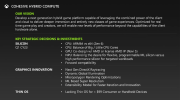How much difference would that actually make? PS5's IO isn't being pushed even now, and lower latencies will still be too long to operate as virtual RAM. I kinda feel 16 GBs RAM, same IO, with just chunky lots more CPU and especially GPU would achieve more. Of course, you'll take the natural improvements so if twice the IO BW is only a buck or two more, you'd spend that. Putting it another way, adding more RAM to PS5 won't make much, if any, difference. Increasing PS5's IO speed won't make any difference. Increasing CPU will get some smoother framerates and upping the graphics will make everything prettier.
About the most exotic idea I can think of that's reasonable - a second pool of slow DRAM between RAM and IO. Could do something like 4-16 GBs to supplement the IO stack to get those latencies down to RAM speeds, though not main RAM speeds. Though the added complexities of more buses might make it not cost effective. I kinda feel RAM topology is the only area with room to play. Fast IO -> DRAM cache -> GDDR -> 3D cache on GPU
I think the key issues moving forwards will be getting lots of ML power that actually gets used, upscaling tech, and address the issues of BVH maintenance. Design hardware around those and they'll prop up everything else very effectively.




